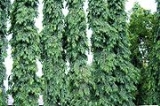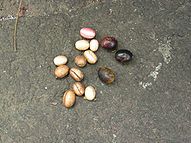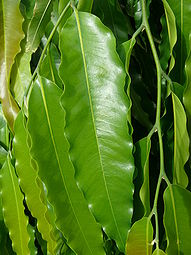
Polyalthia longifolia
Encyclopedia


Polyalthia Longifolia is sometimes incorrectly identified as Ashoka tree (Saraca Indica)because of very close resemblance of both trees.
One might mistake it as a tree with effectively without branches, but in fact an Ashoka allowed to grow naturally (without trimming the branches out for decorative reasons) grows into a normal large tree with plenty of shade. The two look identical in every way, trunk and leaves and bark and flowers, and it is perfectly obvious the straight ramrod versions are specially created much as the trimmed trees along lake Geneva are in another shape.
Common names
Polyalthia longifolia's common names include False Ashoka, the Buddha Tree, Indian mast tree, and Indian Fir tree. Its names in other languages includeAshoka or Devadaru in SanskritSanskrit
Sanskrit , is a historical Indo-Aryan language and the primary liturgical language of Hinduism, Jainism and Buddhism.Buddhism: besides Pali, see Buddhist Hybrid Sanskrit Today, it is listed as one of the 22 scheduled languages of India and is an official language of the state of Uttarakhand...
, Debdaru in Bengali
Bengali language
Bengali or Bangla is an eastern Indo-Aryan language. It is native to the region of eastern South Asia known as Bengal, which comprises present day Bangladesh, the Indian state of West Bengal, and parts of the Indian states of Tripura and Assam. It is written with the Bengali script...
and Hindi
Hindi
Standard Hindi, or more precisely Modern Standard Hindi, also known as Manak Hindi , High Hindi, Nagari Hindi, and Literary Hindi, is a standardized and sanskritized register of the Hindustani language derived from the Khariboli dialect of Delhi...
, Asopalav (Gujarati
Gujarati language
Gujarati is an Indo-Aryan language, and part of the greater Indo-European language family. It is derived from a language called Old Gujarati which is the ancestor language of the modern Gujarati and Rajasthani languages...
),Glodogan tiang (Indonesian
Indonesian language
Indonesian is the official language of Indonesia. Indonesian is a normative form of the Riau Islands dialect of Malay, an Austronesian language which has been used as a lingua franca in the Indonesian archipelago for centuries....
),devdar in marathi and Nettilinkam in Tamil
Tamil language
Tamil is a Dravidian language spoken predominantly by Tamil people of the Indian subcontinent. It has official status in the Indian state of Tamil Nadu and in the Indian union territory of Pondicherry. Tamil is also an official language of Sri Lanka and Singapore...
. araNamaram: അരണമരം (Malayalam
Malayalam language
Malayalam , is one of the four major Dravidian languages of southern India. It is one of the 22 scheduled languages of India with official language status in the state of Kerala and the union territories of Lakshadweep and Pondicherry. It is spoken by 35.9 million people...
).
There are two important traditions associated with the tree (presumably in its full, untrimmed, form with spreading branches), one being of Sita
SITA
SITA is a multinational information technology company specialising in providing IT and telecommunication services to the air transport industry...
taking shelter in the shade of Ashoka when in captivity (found in the Ramayana
Ramayana
The Ramayana is an ancient Sanskrit epic. It is ascribed to the Hindu sage Valmiki and forms an important part of the Hindu canon , considered to be itihāsa. The Ramayana is one of the two great epics of India and Nepal, the other being the Mahabharata...
) and another that of the Ashoka tree requiring a kick from a beautiful woman on spring festival day before it would bloom (in the Malavikagnimitra, for example).However, these associations are made in relation to the real Ashoka tree
Ashoka tree
Saraca asoca is a plant belonging to the Caesalpiniaceae subfamily of the legume family. It is an important tree in the cultural traditions of the Indian Subcontinent and adjacent areas.-Description:...
not the false Ashoka tree (Polyalthia longifolia).
Distribution
Found natively in IndiaIndia
India , officially the Republic of India , is a country in South Asia. It is the seventh-largest country by geographical area, the second-most populous country with over 1.2 billion people, and the most populous democracy in the world...
and Sri Lanka
Sri Lanka
Sri Lanka, officially the Democratic Socialist Republic of Sri Lanka is a country off the southern coast of the Indian subcontinent. Known until 1972 as Ceylon , Sri Lanka is an island surrounded by the Indian Ocean, the Gulf of Mannar and the Palk Strait, and lies in the vicinity of India and the...
. It is introduced in gardens in many tropical countries around the world.
Leaves
Fresh leaves are a coppery brown color and are soft and delicate to touch, as the leaves grow older the color becomes a light green and finally a dark green. The leaves are shaped like a lance and have wavy edges.The leaves are larval food plant of the kite swallowtails.Flowering
_flowers_w2_img_7047.jpg)
Fruit are borne in clusters of 10-20. Initially green but turning purple or black when ripe. These are loved by birds, such as the Asian Koel
Asian Koel
The Asian Koel is a member of the cuckoo order of birds, the Cuculiformes. It is found in South Asia, China, and Southeast Asia. It forms a superspecies with the closely related Black-billed and Pacific Koels which are sometimes treated as subspecies...
Eudynamys scolopaceus and bat
Bat
Bats are mammals of the order Chiroptera "hand" and pteron "wing") whose forelimbs form webbed wings, making them the only mammals naturally capable of true and sustained flight. By contrast, other mammals said to fly, such as flying squirrels, gliding possums, and colugos, glide rather than fly,...
s including the flying foxes.
The leaves are good and for ornamental decoration and used in festivals. The tree is a main attraction in gardens throughout India. The tree can be cut into various shapes and maintained in required sizes. In past, the flexible, straight and light-weight trunks were used in the making of masts for sailing ships. That is why, the tree is also known as the Mast Tree. Today, it is mostly used for manufacturing small articles such as pencil boxes etc.
Methanolic extracts of Polyalthia longifolia have yielded 20 known and two new organic compounds, some of which show cytotoxic properties.

